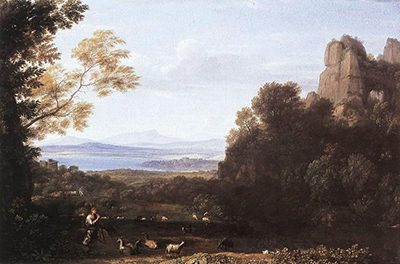Landscape with Apollo and Mercury was created by Claude Lorrain in 1660, by which time he would have been in his mid to late fifties and entirely settled living in the Italian city of Rome.
He chooses to include very little sign of humanity within this particular piece, covering the subject title with just a few figures in the foreground. Some trees cover both sides of the painting, but leave an opening through which we can see far into the distance. A rocky hill lies to the right, reaching up towards the top of the canvas. A lake can be spotted, and perhaps also a large town as well. There are a number of mountains further back, with a bright sky then covering the upper half of the composition. Generally speaking, Claude would use fairly calm and clear skies within his paintings, and it was only later with the Romanticists that emotion would start to appear within the more extreme, lively depictions of nature and the environment. Claude's role was to make landscape art a respected specialisation, with others then following on afterwards to develop and evolve this art form onwards.
The artist was trained in Italy having moved there from Lorrain, which is in modern-day France. It took him time and considerable struggle to learn his craft and establish himself as a professional artist but eventually he managed it and it was clear from an early point that his passion lied in the landscape genre. Rome would be his home for many years and its countryside would inspire the style of many of his paintings, whilst classical architecture would also regularly feature throughout his career. Figures seen such as with Apollo and Mercury in this piece were always sat in the foreground, relatively small, and this avoided exposing his relative weakness in figurative art. He perhaps understood his weaknesses and this may have been why his oeuvre is so consistent, reflecting his awareness of his own limitations. This safe path provided a consistency which collectors and patrons alike loved and his reputation soared to impressive heights after working in Italy for a number of decades.
Lorrain is today regarded as a key artist in the evolution of European art, helping to bring about new movements in the 18th and 19th century, with artists taking advantage of the progress that he had made. Technically, he impressed most in the calm landscapes which he delivered to his many patrons, though his use of mythology and religion would also be important to them at that time. Today, his content is summarised with a bias towards his landscapes, particularly because of how he helped to bring others into this genre by achieving a much increased respect for it from academics, historians, critics and patrons. His abilities were also used in drawing, watercolours and etchings too, which helped to spread his work even further.




